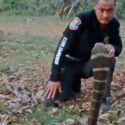They’re fast. They’re sticky. And they are deadly. These lizards can chase you on land, water and even air. Their camouflage helps them hide in the wild. They could be next to you right now. With sharp claws and teeth, and scaly skin, these reptiles can look threatening.
And although these creatures don’t usually attack for no reason, when they do, it can be painful, traumatic and deadly. Today we’ll take a look at the five most dangerous lizards, where to find them, and how to avoid getting killed. Which deadly lizards are more commonly known as housepets? How can you identify the poisonous ones? And which lizard could eat you alive?
Whether you’re a tourist stranded in a jungle, a curious visitor at a zoo, or if you like to own exotic pets, a lizard attack could happen to almost anyone. We’ll start our countdown in North America.
Number 5. Gila Monster
This lizard lives in Arizona, California, Nevada, Utah and New Mexico, and Mexico’s Sonora and Sinaloa states.
They’re black with orange or beige with black blotches, which help it blend into its surroundings. Its big tail stores fat, allowing it to survive for months without eating.
Gila monsters are relatively small lizards, approximately 50 cm (20 in) long and weighing about 2 kg (4 lb).
They bite their victims and grip them. Then they chew on the wound so their teeth can deliver the venom in their jaws.
The venom contains a mild neurotoxin that’s about as strong as rattlesnake venom. Some deaths may have occurred many decades ago before people realized how potent the Gila’s venom is. But the last suspected human death from a Gila monster bite happened in 1939.
Number 4. Mexican Beaded Lizard
These lizards, along with its close relative, the Gila Monster, are the only two species of poisonous lizards in the world. They live in the Mexican states of Sinaloa, Sonora and most of Mexico’s Pacific coast down to the Guatemala border.
They’re black or brown with white spots and bead-like scales. And they grow up to 80 cm (31 in) long. Just like their cousins, the Mexican beaded lizard has sharp teeth and strong jaws. When they lock onto their prey, they release venom through the funnels on their grooved teeth. Their bites can be painful, but they mainly use their venom to defend themselves against predators.
Number 3. Nile Monitor
These tree-dwelling lizards are found near many sub-Saharan African rivers, including the Nile. They are brownish or greenish-gray, giving them camouflage in their environment. The Nile monitor has big claws and a strong tail, making it a great swimmer and climber, as these lizards live in swamps, woodlands, and other habitats.
They weigh about 20 kg (44 lb) and can be up to 2.5 m (8 ft) long. These big lizards are solitary creatures, which means they can get incredibly aggressive if you approach them. They often eat eggs, fish, and rodents. But their sharp teeth and powerful jaws can do great harm to a human. The venom in their saliva is not strong enough to kill a person, but their violent attacks could end a child’s or small pet’s life.
Number 2. Green Iguana
This is the most common species of iguana. It inhabits various regions throughout Mexico and South America, particularly Brazil. And it is easy to find them in many parts of the United States, where people keep them as pets. Male green iguanas can grow up to 2 m (6.6 ft) and weigh as much as 6 kg (13 lb).
If you provoke or agitate a green iguana, it can seriously injure you. It will use its dozens of sharply serrated teeth, pointy claws and whip its tail against your skin. Sometimes iguanas will warn you by lowering the flap of skin beneath their chins, called a dewlap, and inhaling to appear bigger.
And older male iguanas are more likely to act aggressively. In 2017, in Miami, Amanda Gray’s pet iguana attacked her. She was trying to feed Igmo when the iguana attacked her with its sharp nails. Amanda got several facial injuries and required stitches.
The iguana got another home with a more experienced handler. Before going to our number one deadly lizard, let’s see how you could survive the beasts we’ve seen so far. To escape from the Mexican beaded lizard or the Gila Monster, pry them off. You can usually do this by holding the lizard’s torso and forcefully removing them.
If one bites you, immediately wash the injured area and seek medical attention.
If you see a Nile monitor, stay away, and stay on land. Don’t try to escape by swimming or climbing a tree because they will be faster than you are. Also, keep small children and pets away from them. If you have a pet green iguana, keep its nails clipped. And wear thick falconry gloves when you handle it.
If you get bitten, immediately clean the wound using soap and water or saline solution, and apply an antibiotic ointment. Then cover the wound with a bandage, and go to a hospital’s emergency room. If you have an iguana that acts aggressively, consider giving it to a more experienced handler. And now for our lizard heavyweight.
Number 1. Komodo Dragon
Komodo Dragons are native to Komodo island and other islands throughout Indonesia. Most of them are in Komodo National Park. They can be 3 m long (10 ft) and as heavy as 166 kg (366 lb). They will often ambush animals like wild boars and deer. Biting injects venom into their prey, and its blot clotting inhibitor slowly causes shock in the victim.
A Komodo’s mouth also transfers infectious bacteria, which overtakes the animal’s immune system. The dragon will follow its victim, and once it is extremely weak, the Komodo eats it — alive or dead. These big dragons can run incredibly fast, and they have chased and attacked humans.
If you want to survive on Komodo Island, don’t leave the park’s trails, don’t make loud noises and stick with your group. This massive lizard hunts prey that is alone. Komodo dragons can smell blood from km or miles away, so menstruating women and people with open wounds should stay away from the park.
If one chases you, run in a zig-zag pattern to confuse the dragon, as they can only run in a straight line. If you get bitten and you’re bleeding, soon there will be more hungry lizards looking for you. So try to leave the place and get medical help immediately.
You survived the most dangerous lizards, even having one as a pet. But some people don’t stop there and go as far as having tigers or bears as pets. Would you have a poisonous snake as your loyal companion?
Sources
- “7 Of The World’S Most Dangerous Lizards And Turtles”. 2021. Encyclopedia Britannica.
- “10+ List Of Venomous Lizards – With Photos“. 2021. Animalwised.Com.
- “10 Terrifying And Dangerous Turtles And Lizards“.Ron Harlan May 22, 2013 for listverse. 2021. The Sun Chronicle .
- “Lure Of The Exotic Stirs Trouble In The Animal Kingdom (Published 2002)“. 2002. Nytimes.Com.
- “Man Eaten By His 6Ft-Long Pet Lizards ‘Was Also Killed By The Creatures‘”. The Sun.



























